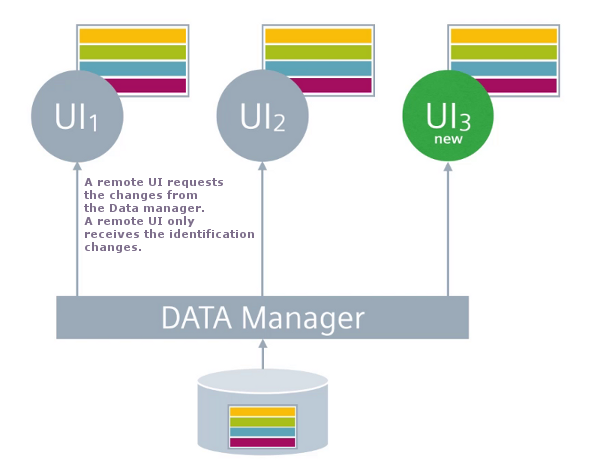Identification Caching
The identification caching provides you an advantage especially when using remote user interfaces and distributed systems. Identification caching allows the identification to be sent as “delta” instead of the whole identification. Thus, only the changes are sent by the Data and the Dist managers.
Incremental DP Identification Updates
The sending of the “deltas” (only changes) fastens up the process significantly. A remote UI or a Dist manager only receives the identification changes. A UI or the Dist manager uses the changes in order to update the identification to the current state. In other words, when a manager (a Dist manager or a remote UI) possesses an identification that is not current, it can be updated by using "deltas". The deltas are sent when Dist managers establish a connection and when a remote UI is restarted. Thus, In a distributed system, the whole identification is not being sent anymore but only the changes are transmitted in case of a network failure.
Identification Caching
The identification caching comprises not only the sending of "delta" updates but also the caching of identification.
What is an identification
The identification contains the structure of the data types in a " TypeContainer " and the data point identifications " DP IDs ". CNS and time stamp again are a part of the DP ID. There is one identification per system.
The identification of the systems is also exchanged when configuring a distributed system. The identification is exchanged to be able to use the DPs on remote systems (see also Principle and functionality of distributed systems). The Data Manager administers the identification. Each manager gets the Identification from the Data Manager when starting. (Exception: when using the identification caching, the Identification is saved in files on a hard disk - see the description below).
Caching of Identification (Remote UI):
A remote UI writes its identification to the hard disk and reads the cached identification when it starts and requests the changes from the Data manager.

Caching of Identification (Dist manager):
If the Dist manager is restarted but the Data manager of a system is still running, the Dist manager receives the necessary information for all remote systems from the Data manager, in order to request the updates for those identifications, from the remote systems.
Caching of Identification (Data manager):
The Data manager saves the identification of the current system in the database but the identifications of remote systems in a distributed system remain only in the RAM. If you restart the system and thus the Data manager, the identifications of the remote systems are lost. Without using the "Caching of Identification" the Dist manager that connects to a remote Dist system, has to request the whole identification of that system. By using the "Identification Caching", the Data manager writes the remote identifications to the hard disk. When the system and the Data manager is restarted, the Data manager reads the remoteidentificationsfrom the hard disk. Thus, when the system is started, it possesses allidentificationsthat existed when the system was stopped. Therefore, the Dist manager can request only the changed data from a remote Dist system as if the system was not stopped at all.
Caching the identification provides the advantage that it is immediately ready to use by all managers. The Dist manager requests deltas only from other systems, thus reducing the time to start up after a complete system restart and when using slow network connections.
Functionality
Both the Dist and the Datamanager buffer the change messages of the identification .
The identification of each system contains a time stamp. The time stamp is a part of the DP identification. Each time the identification changes, the time stamp is incremented by one. When a Dist manager connects to another system, it requests the changes according to the current time stamp of the remote identification. Only changes since the current time stamp are sent.
Clients that cache the identification to hard disk, know the time stamps of all identifications at the start and only request changes that occurred after these time stamps.



